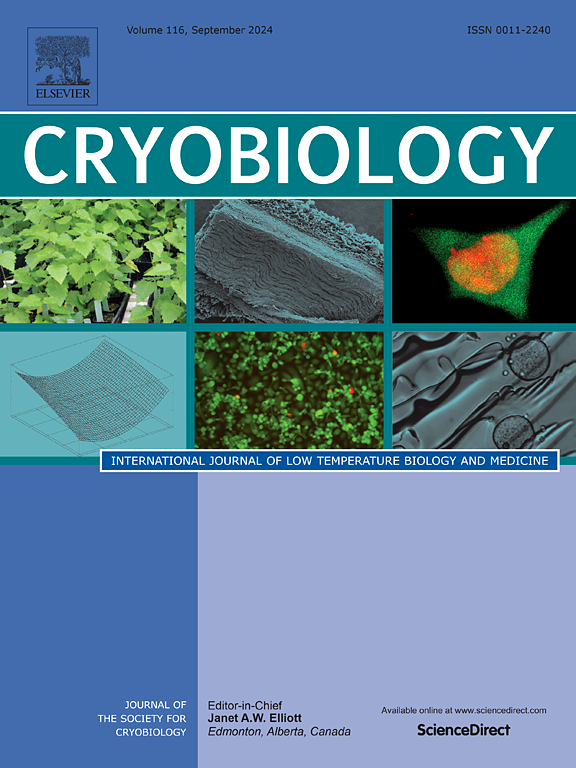磷脂酰丝氨酸易位、胆固醇空间分布和顶体反应可靠地区分了牛精子的获能性和低温损伤
IF 2.1
3区 生物学
Q2 BIOLOGY
引用次数: 0
摘要
精子获能是成功受精的关键过程,涉及多种调控的细胞变化。另一方面,低温保存诱导的膜变化可以模拟获能,潜在地导致对精子功能的误解。区分真正的能化和冷冻损伤仍然具有挑战性,因为尽管涉及不同的机制和受精影响,两者都有表面标记。本研究旨在评估各种技术在检测关键的能力相关事件并将其与低温保存引起的损伤区分开来方面的有效性。收集12头公牛(每头3次,n = 36)的精液样本,分为对照组(CO)和体外获能组(CAP)。分析所有样本的精子浓度、运动特性和与获能相关的事件,包括膜脂紊乱、脂质过氧化、磷脂酰丝氨酸易位、胆固醇再分布、顶体反应和线粒体膜电位。初步分析后,将精液冷冻保存、解冻,然后分成冷冻对照组(CRYCO)和活化组(CRYCAP)重新分析。数据采用方差分析,均数比较采用Tukey检验(显著性水平≤5%)。所有测量变量之间的相关性也被检查。无论冷冻保存状态如何,获能诱导降低了曲线速度,同时增加了直线度、磷脂酰丝氨酸易位、胆固醇外排和顶体反应精子。相比之下,低温保存后,质膜破坏和脂质过氧化明显升高,胆固醇再分布减少。值得注意的是,在新鲜和冷冻保存的精子中,磷脂酰丝氨酸易位与顶体反应之间存在很强的正相关。综上所述,磷脂酰丝氨酸易位、胆固醇空间分布和顶体反应是区分真能化和低温损伤最可靠的标志。本文章由计算机程序翻译,如有差异,请以英文原文为准。

Phosphatidylserine translocation, cholesterol spatial distribution, and acrosome reaction reliably distinguish sperm capacitation from cryoinjury in bovine sperm
Sperm capacitation is a critical process for successful fertilization, involving multiple regulated cellular changes. On the other hand, cryopreservation induces membrane changes that can mimic capacitation, potentially leading to misinterpretation of sperm function. Distinguishing true capacitation from cryoinjury remains challenging, as both share surface markers despite involving distinct mechanisms and impacts on fertilization. This study aimed to assess the effectiveness of various techniques in detecting key capacitation-related events and differentiating them from cryopreservation-induced injuries. Semen samples from twelve bulls (three ejaculates each; n = 36) were collected and divided into control (CO) and in vitro capacitated (CAP) groups. All samples were analyzed for sperm concentration, motility characteristics, and capacitation-associated events – including membrane lipid disorder, lipid peroxidation, phosphatidylserine translocation, cholesterol redistribution, acrosome reaction, and mitochondrial membrane potential. Following the initial analysis, semen was cryopreserved, thawed, and then split into cryopreserved control (CRYCO) and capacitated (CRYCAP) groups for reanalysis. Data were evaluated using ANOVA, with means compared by Tukey's test (significance level ≤5 %). Correlations among all measured variables were also examined. Capacitation induction decreased curvilinear velocity, while increasing straightness, phosphatidylserine translocation, cholesterol efflux, and acrosome-reacted sperm, regardless of cryopreservation status. In contrast, plasma membrane disorganization and lipid peroxidation were markedly elevated, and cholesterol redistribution was reduced after cryopreservation. Notably, a strong positive correlation was observed between phosphatidylserine translocation and acrosome reaction in both fresh and cryopreserved sperm. In conclusion, phosphatidylserine translocation, cholesterol spatial distribution, and the acrosome reaction were the most reliable markers for distinguishing true capacitation from cryoinjury.
求助全文
通过发布文献求助,成功后即可免费获取论文全文。
去求助
来源期刊

Cryobiology
生物-生理学
CiteScore
5.40
自引率
7.40%
发文量
71
审稿时长
56 days
期刊介绍:
Cryobiology: International Journal of Low Temperature Biology and Medicine publishes research articles on all aspects of low temperature biology and medicine.
Research Areas include:
• Cryoprotective additives and their pharmacological actions
• Cryosurgery
• Freeze-drying
• Freezing
• Frost hardiness in plants
• Hibernation
• Hypothermia
• Medical applications of reduced temperature
• Perfusion of organs
• All pertinent methodologies
Cryobiology is the official journal of the Society for Cryobiology.
 求助内容:
求助内容: 应助结果提醒方式:
应助结果提醒方式:


